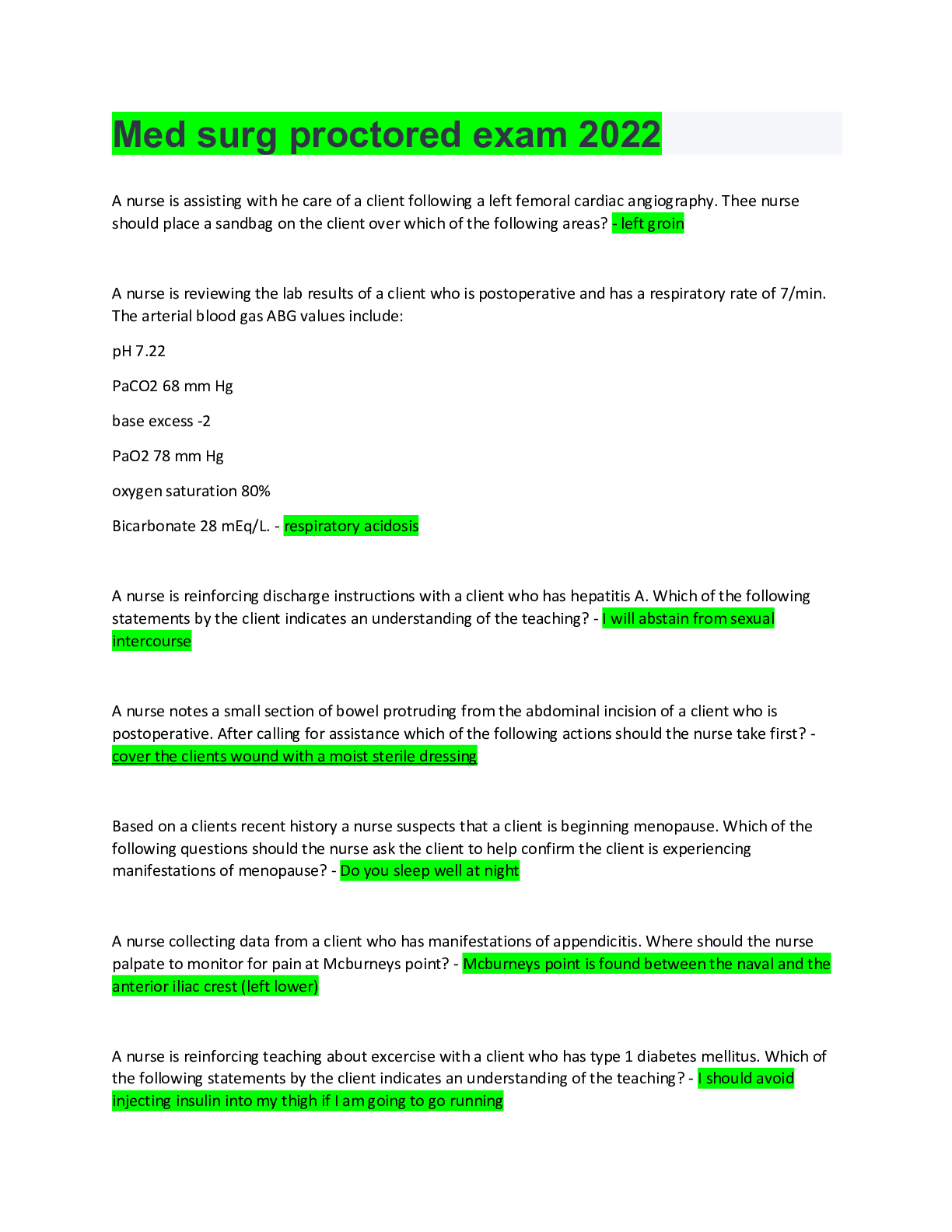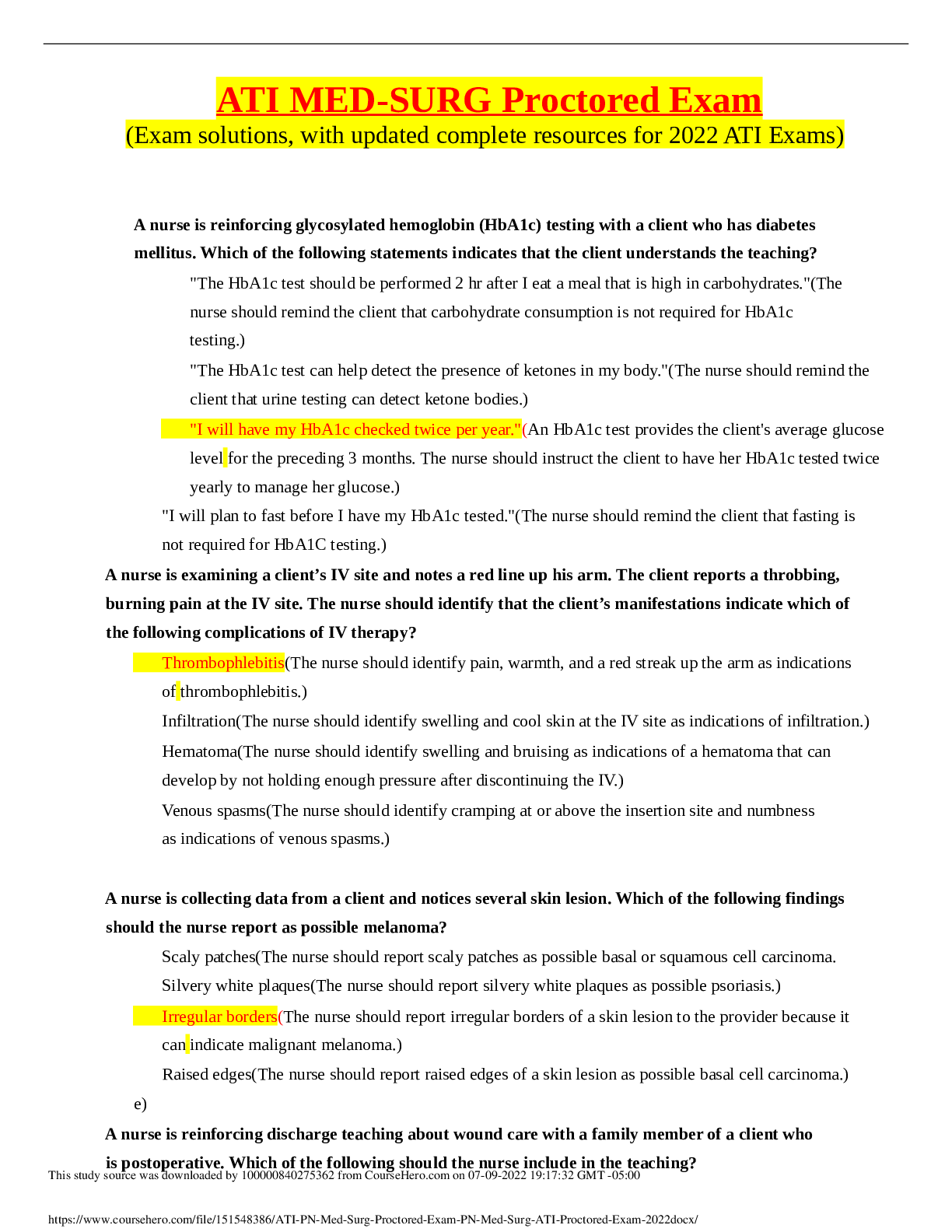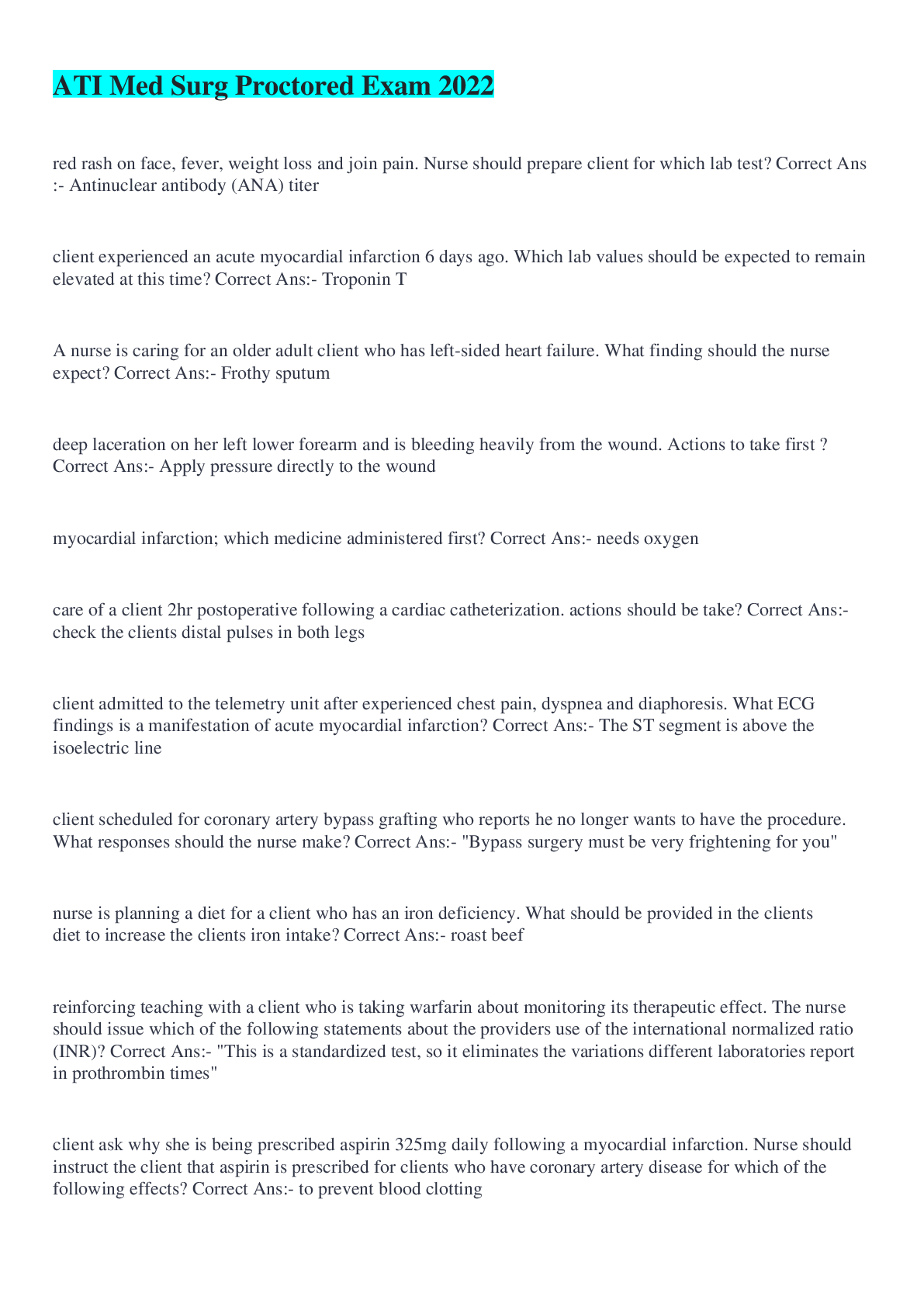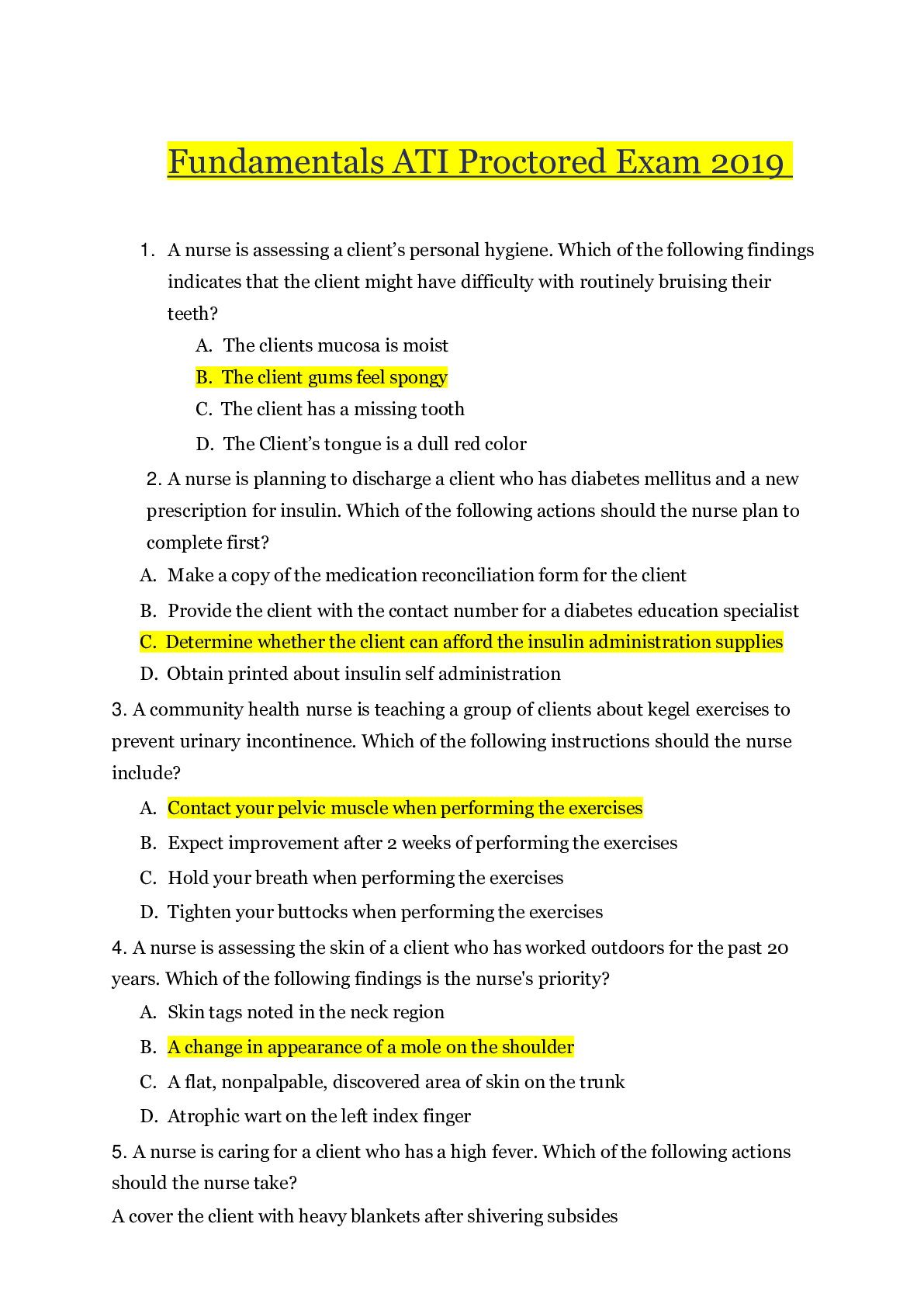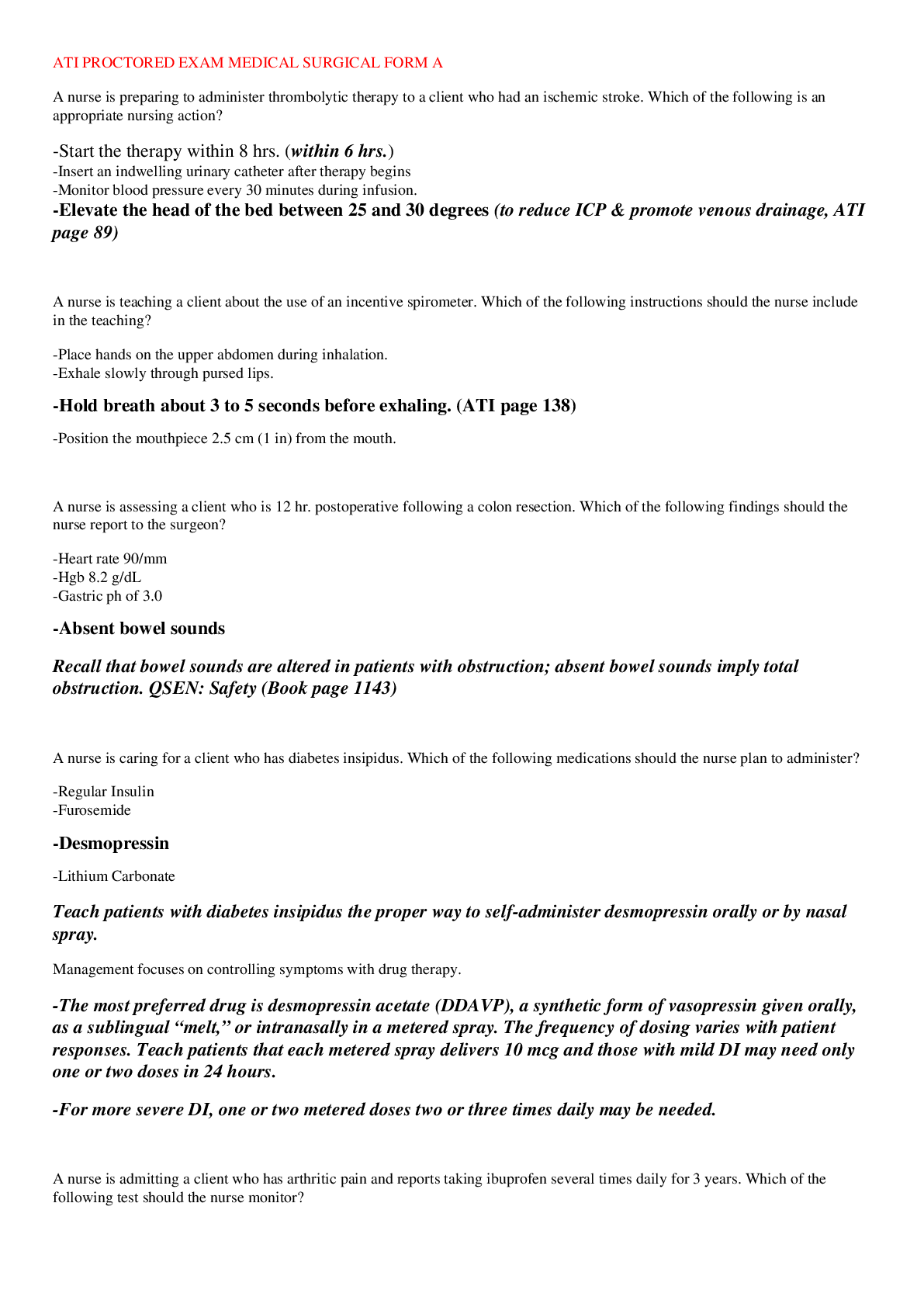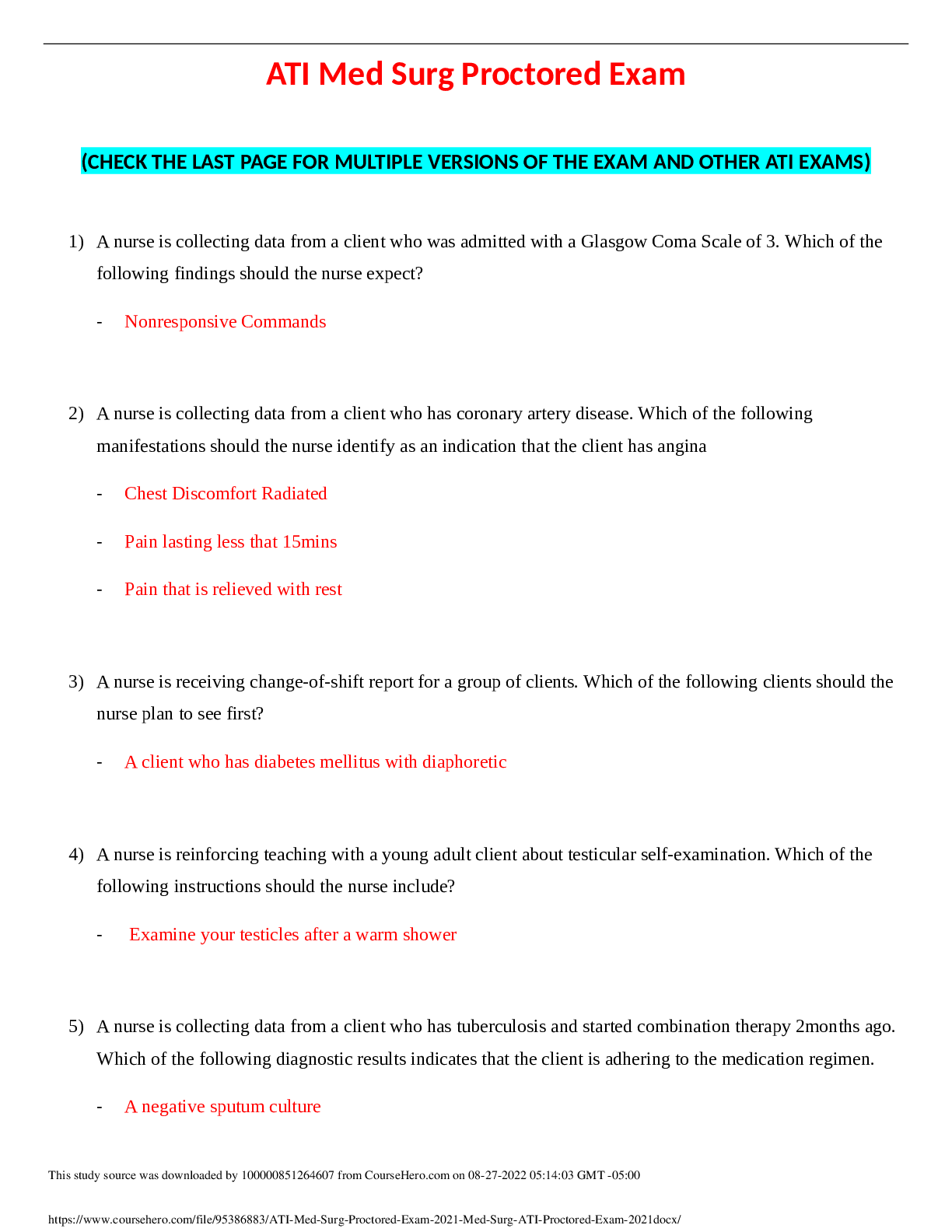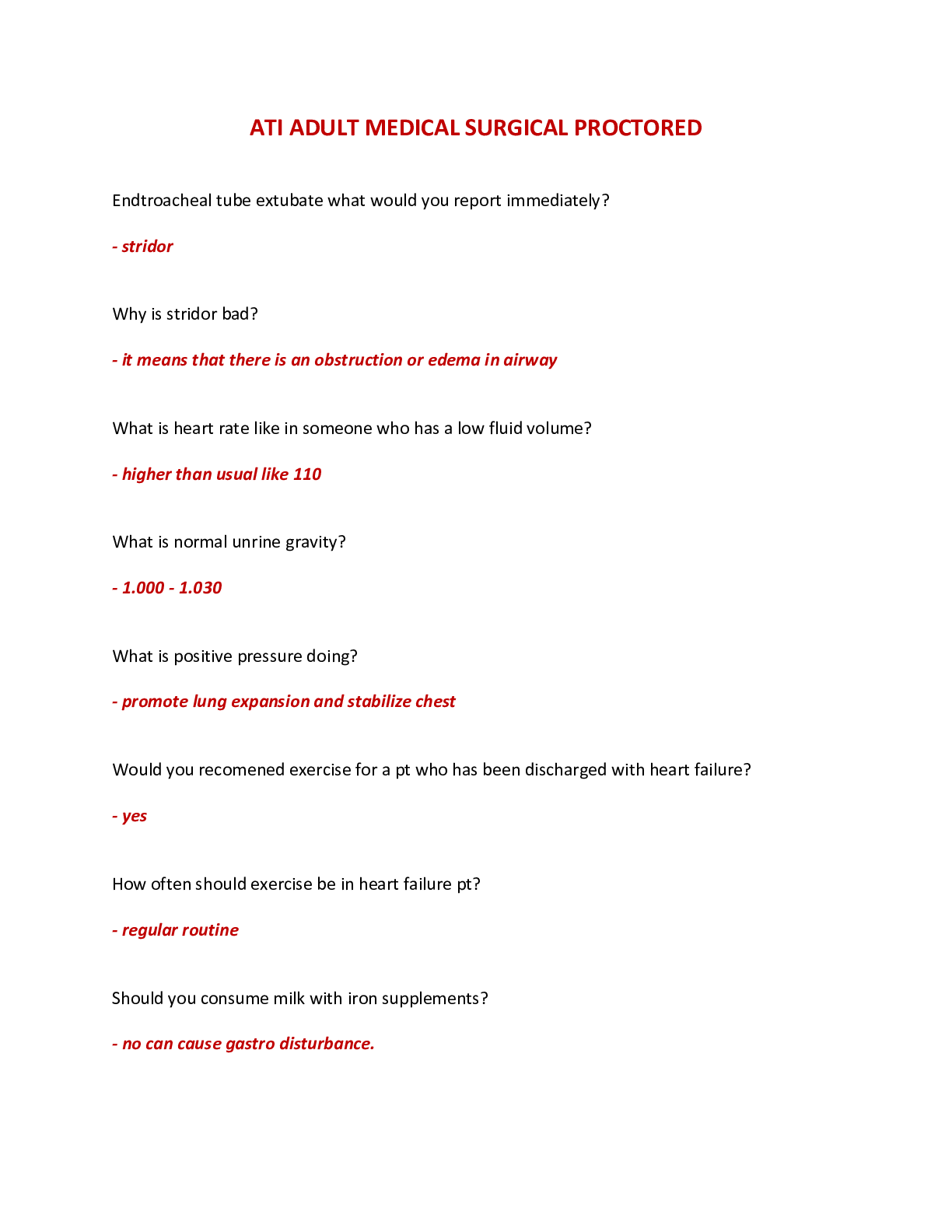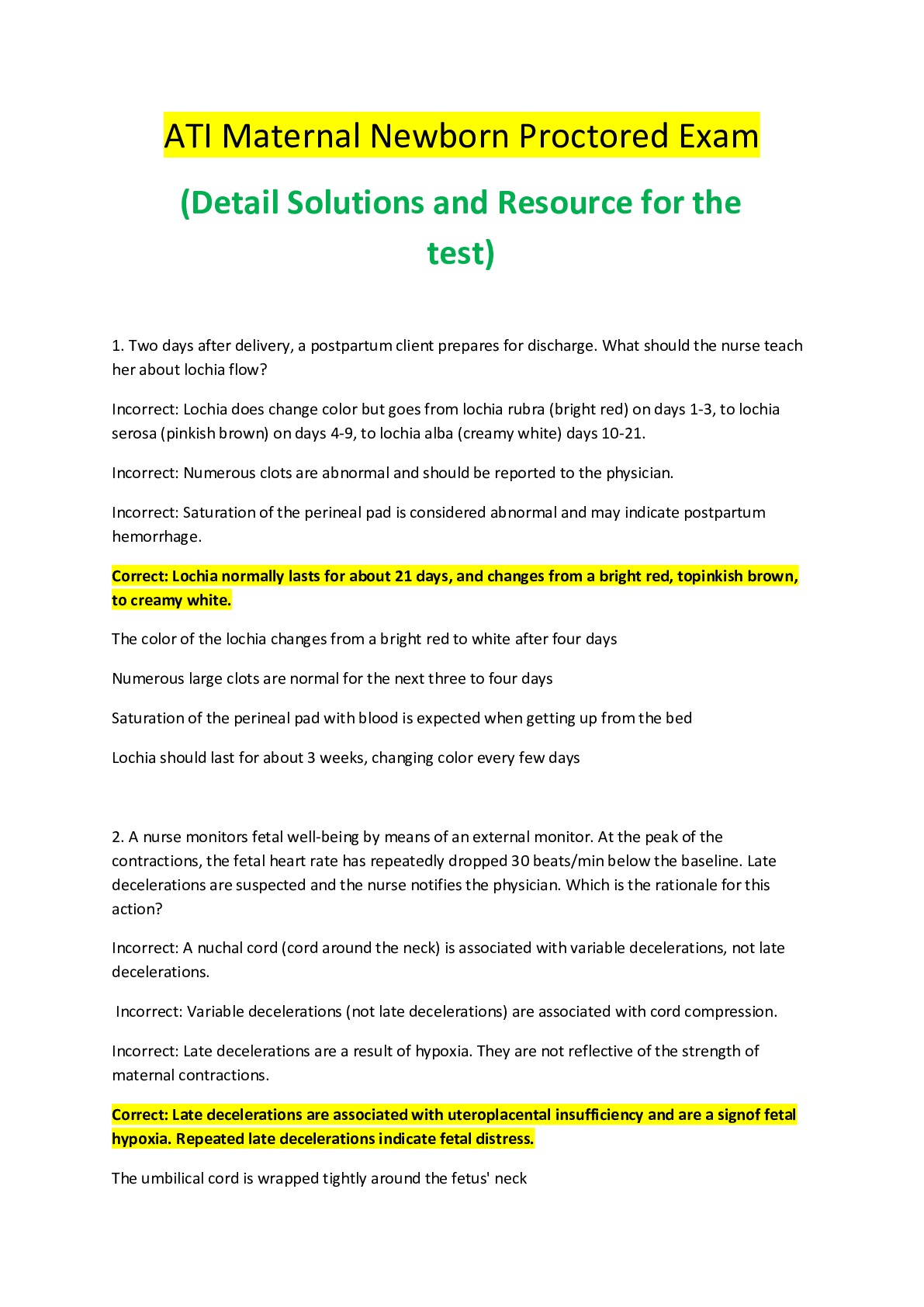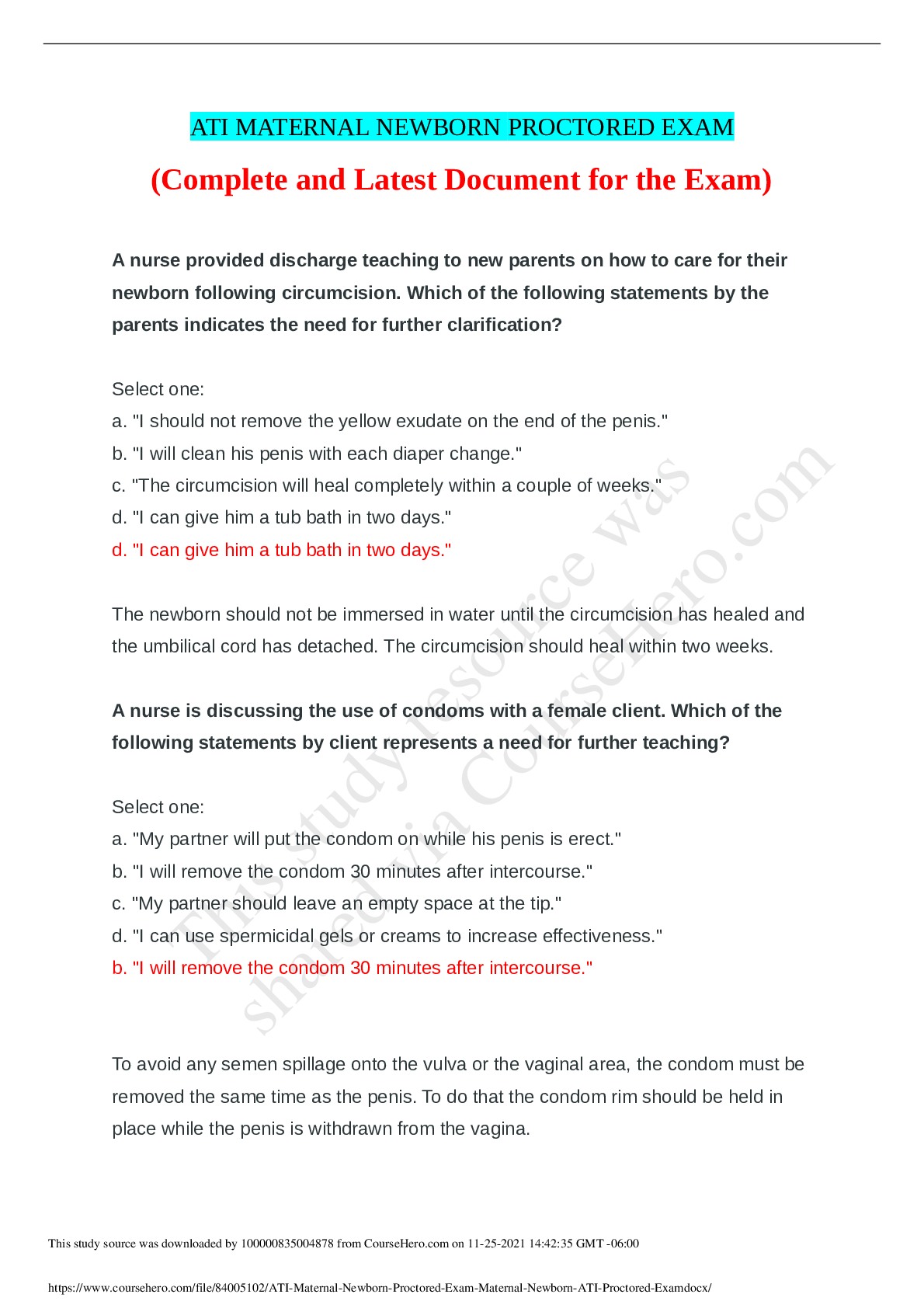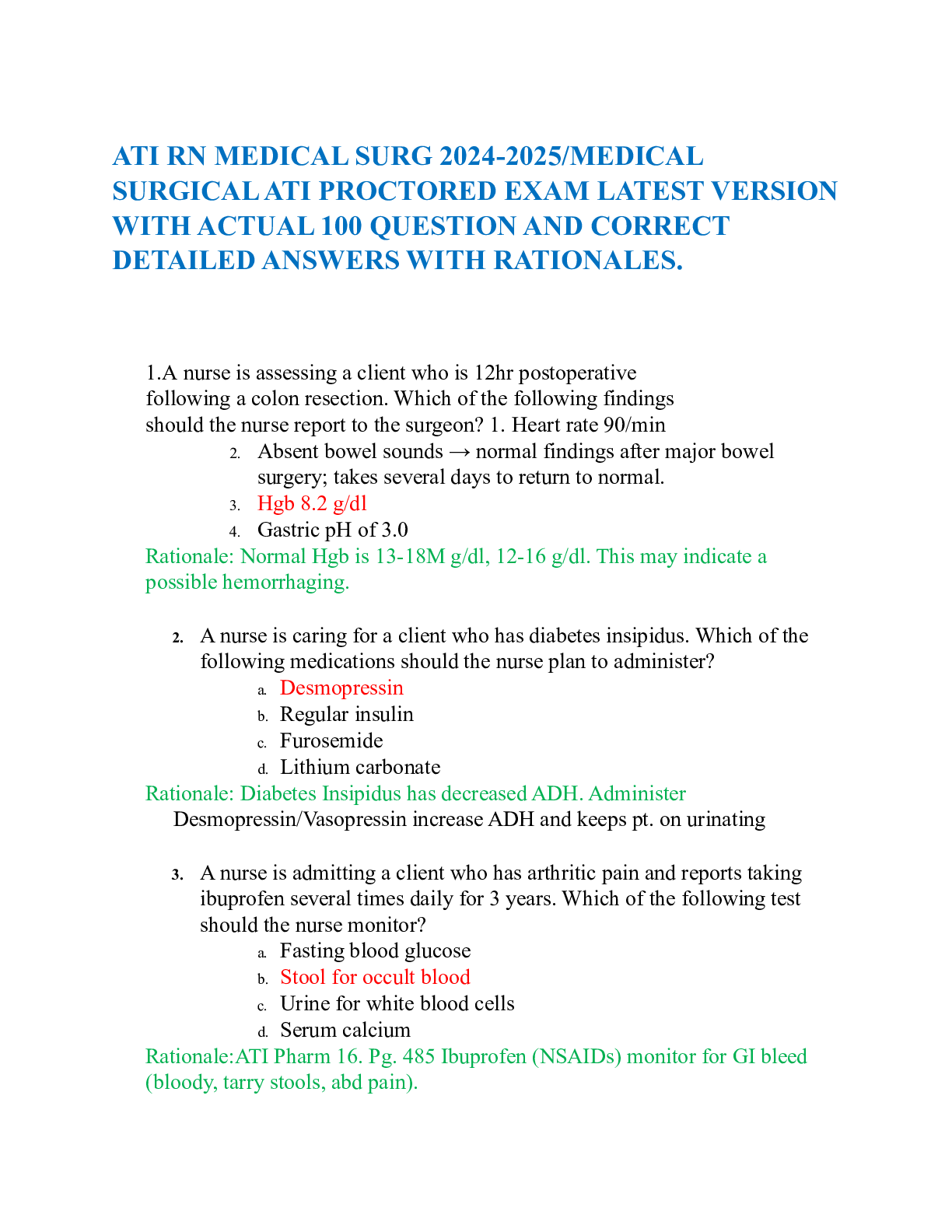*NURSING > ATI MEDICAL SURGICAL > Medical surgical ATI proctored exam review 2022 (All)
Medical surgical ATI proctored exam review 2022
Document Content and Description Below
Medical surgical ATI proctored exam review 2022 What would you do for wound Evisceration ( removal of internal organs) , Emergency management? - Saline cover wound What would you do for an ASTHMA ... emergency management of a bee sting allergies? - Epi Pen Seizures and Epilepsy: Seizure precautions - During a seizure: 1) Position client on the floor 2)Provide a patent airway 3) Turn client to side 4) Loosen restrictive clothing Cancer treatment options: Protective Isolation - If WBC drops below 1,000, place the client in a private room and initiate neutropenic precautions. - Have client remain in his room unless he needs to leave for a diagnostic procedure, in that case transport patient and place a mask on him. - Protect from possible sources of infection (plants, change water in equipment daily) - Have client, staff and visitors perform frequent hand hygiene, restrict ill visitors - Avoid invasive procedures (rectal temps, injections)- Administer (neupogen, neulasta) to stimulate WBC production Infection control: Appropriate room assignment - Standard Precautions: 1. applies to all patients 2. Hand washing a. alcohol based preferred unless hands visually soiled ( then soap and water ) 3. Gloves - when touching anything that has the potential to contaminate. 4. Masks, eye protection & face shields when care may cause splashing or spraying of body fluids Droplet: 1. private room or with someone with same illness 2. masks Airborne: 1. private room 2. masks or respiratory protection devices a. use an N95 respirator for tuberculosis 3. Negative pressure airflow 4. full face protection if splashing or spraying is possible Contact: 1. private room or room with same illness 2. gloves & gowns 3. disposal of infections dressing materials into a single, nonporous bag without touching the outside of the bag TB: Priority action for a client in the emergency department - -Wear an N95 or HEPA respirator-Place client in negative airflow room and implement airborne precautions -use barrier protection when the risk of hand or clothing contamination exists Immunizations: Recommended vaccinations for older adult clients - Adults age 50 or older: - Pneumococcal Vaccine (PPSV) - Influenza vaccine - Herpes Zoster Vaccine - Hepatitis A - Hepatitis B - Meningococcal Vaccine Pulmonary Embolism: Risk factors for DVT - - Long term immobility - Oral contraceptives - Pregnancy - Tobacco use - Hypercoagulabilty - Obesity - Surgery - Heart failure or chronic A-Fib - Autoimmune hemolytic anemia (sickle cell) - Long bone fractures - Advanced age Disorders of the male reproductive system: Complications of continuous irrigation following Transurethral Resection - - Urethral trauma - Urinary retention - Bleeding- Infection Non-modifiable risk factors ( Page 3 ATI ) - 1) Age 2) Gender 3) Genetics 4) Developmental level Modifiable risk factors ( Page 3 ATI ) - 1) Smoking 2) Exercise 3) Health education and awareness 4) Nutrition 5) Sex practices Emergency nursing - Triage - BASED ON ACUITY 1) Emergent- Life threatening situation going on. 2) Urgent - Need to be treated soon but not life threatening. 3) Non urgent- The patient can wait for an extended period of time , without big issues. Mass casualty event - Class 1 - RED TAG - Immediate threat to life Examples: 1) Breathing issues 2) Chest pain 3) Heart attack coming on 4) Airway problem Class II - YELLOW TAG - Major injuries that require immediate treatment but not life threatening.Examples: 1) Major fracture Class III - GREEN TAG - Minor injury that does not require immediate attention. EXAMPLES: 1) Abrasion 2) Laceration Class IV - BLACK TAG - Expected to die EXAMPLES: 1) Penetrating head wound Triage priority setting - 1) Red tag 2) Yellow Tag 3) Green tag 4) Black tag Priorities: general rule - A - Airway - Secure the airway by head tilt , chin lift maneuver unless a fracture in cervical spinal. Brain injury or death in 3 - 5 minutes if airway not patent. B- Breathing - Auscultation of breath sounds, Chest expansion and respiratory effort, Rate and depth of respiration's, Look for chest trauma, Determine tracheal position, Check for jugular vein distension. C- Circulation - Heart rate, BP, Peripheral pulses, Cap refill.D - Disability - Clients level of consciousness with: 1) Glasgow coma scale a) <<< 8 Comatose state b) 3 Client totally unresponsive c) 15 A client within normal limits. E- Exposure - Hypothermia - Patient in cold icy water: 1) Remove wet clothing 2) Provide blankets 3) Increase the temperature of the room 4) Warm IV fluid going into the patient IF patient has had accidental or purposeful poisoning: 1) Activated charcoal 2) Gastric lavage 3) Whole bowel irrigation *** DO NOT INDUCE VOMITING OR SYRUP OF IPECAC Call rapid response team when client is rapidly declining. Cardiac Emergencies - If V fib or ventricular tachycardia you would initiate: 1) Basic life support ( BLS) and CPR 2) Establish IV access 3) Epinephrine is used to get the heart up and moving. Alpha 1 receptors - Activation Causes the skin , mucus membranes and veins to vasoconstrict.Help with: 1) Congestion 2) Superficial bleeding 3) In general help raise blood pressure by constricting the veins. DRUG: Epinephrine:Triggers the Alpha 1 receptors Causing vasoconstriction and increase blood pressure. Epinephrine side effects - Increases blood pressure 1) Hypertensive crisis 2) Dysrhythmia 3) Angina Dopamine side effects - 1) Dysrhythmia 2) Angina Dobutamine side effects - Increased heart rate Beta 1 receptors - Help stimulate the heart Beta I - You have 1 heart Stimulate the heart and increase the heart rate Used for treating: 1) AV block2) Cardiac arrest DRUG: Epinephrine:Triggers the Beta 1 receptors Cause increase heart rate Beta II receptors - Help stimulate the heart and lungs Beta II You have 2 Lungs Causes: 1) Bronchodilation in the lungs 2) Causes uterine smooth muscle to relax 3) Asthma situation DRUG: Epinephrine:Triggers the Beta II receptors Cause bronchodilation and treat Asthma Dopamine - Causes renal blood vessels to dilate. DRUG: Epinephrine: Dopamine receptors and if given a little more Beta I Helps with: 1) Shock [Show More]
Last updated: 1 year ago
Preview 1 out of 62 pages
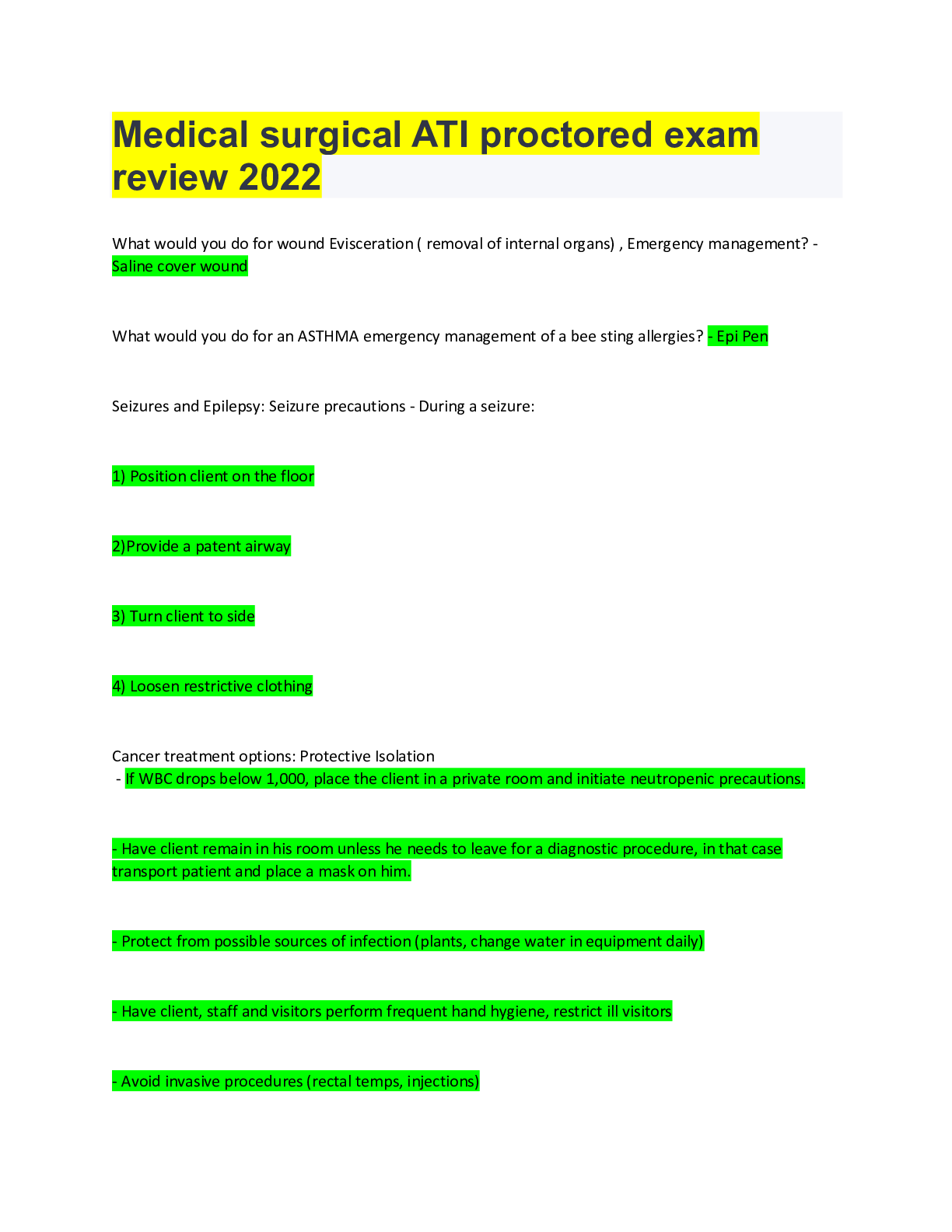
Reviews( 0 )
Document information
Connected school, study & course
About the document
Uploaded On
May 02, 2022
Number of pages
62
Written in
Additional information
This document has been written for:
Uploaded
May 02, 2022
Downloads
0
Views
55

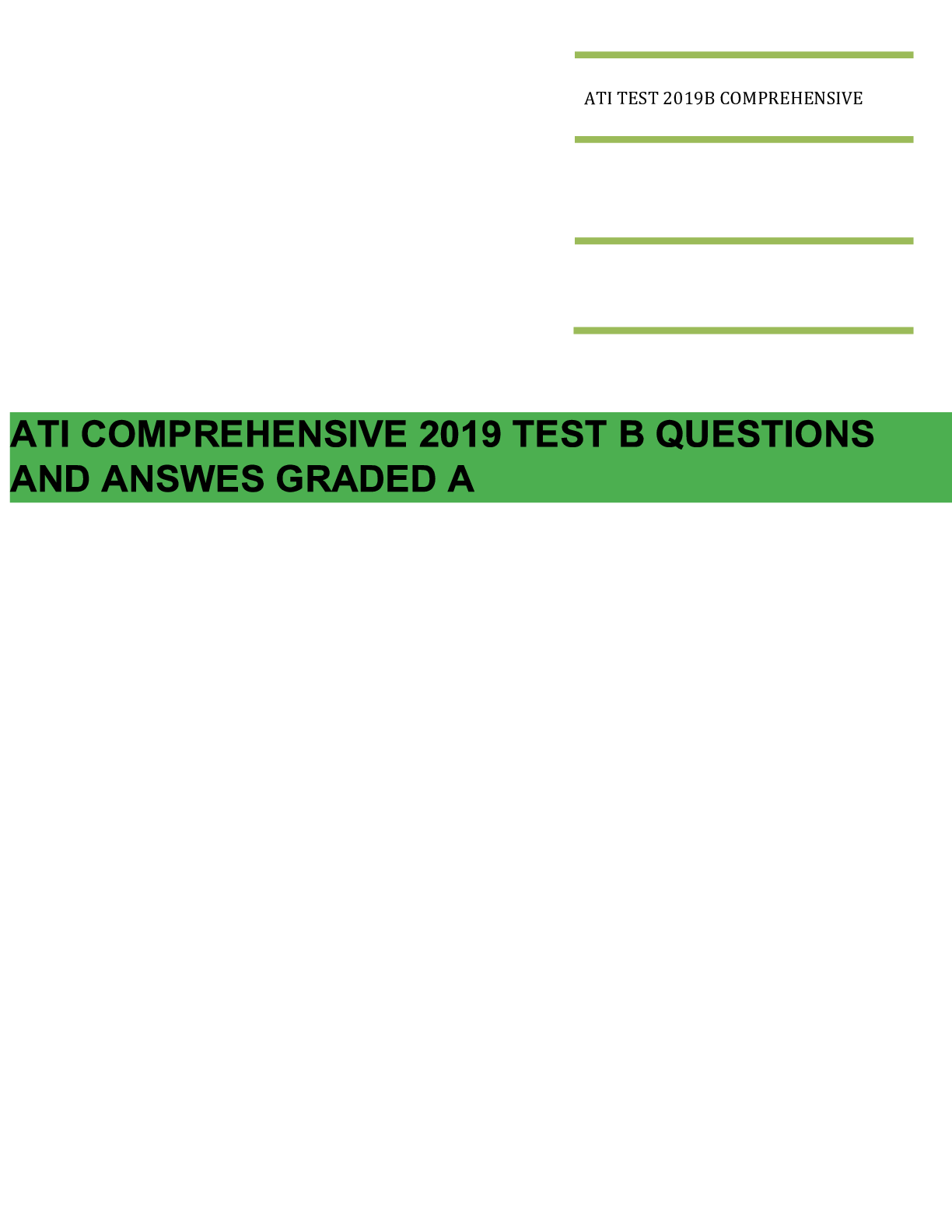
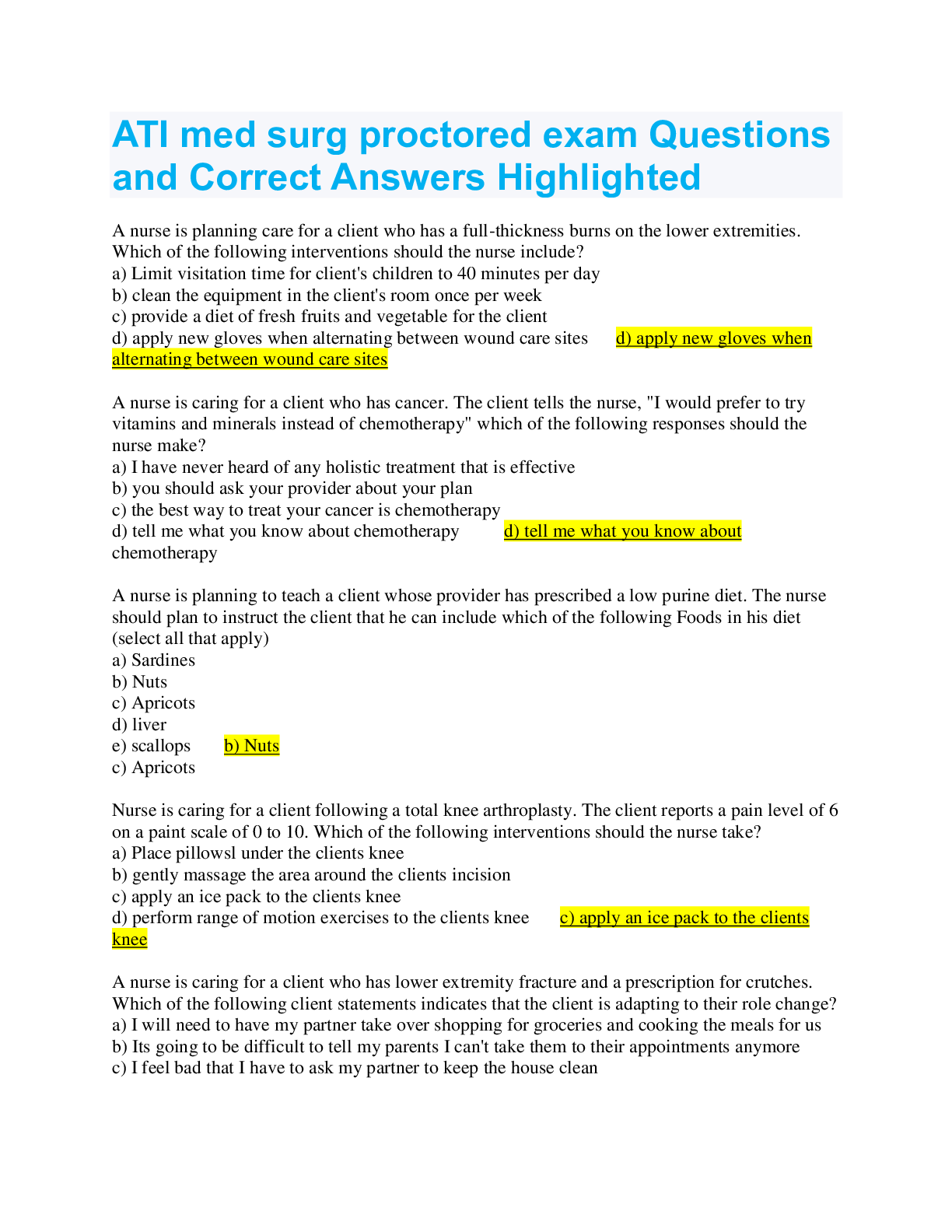


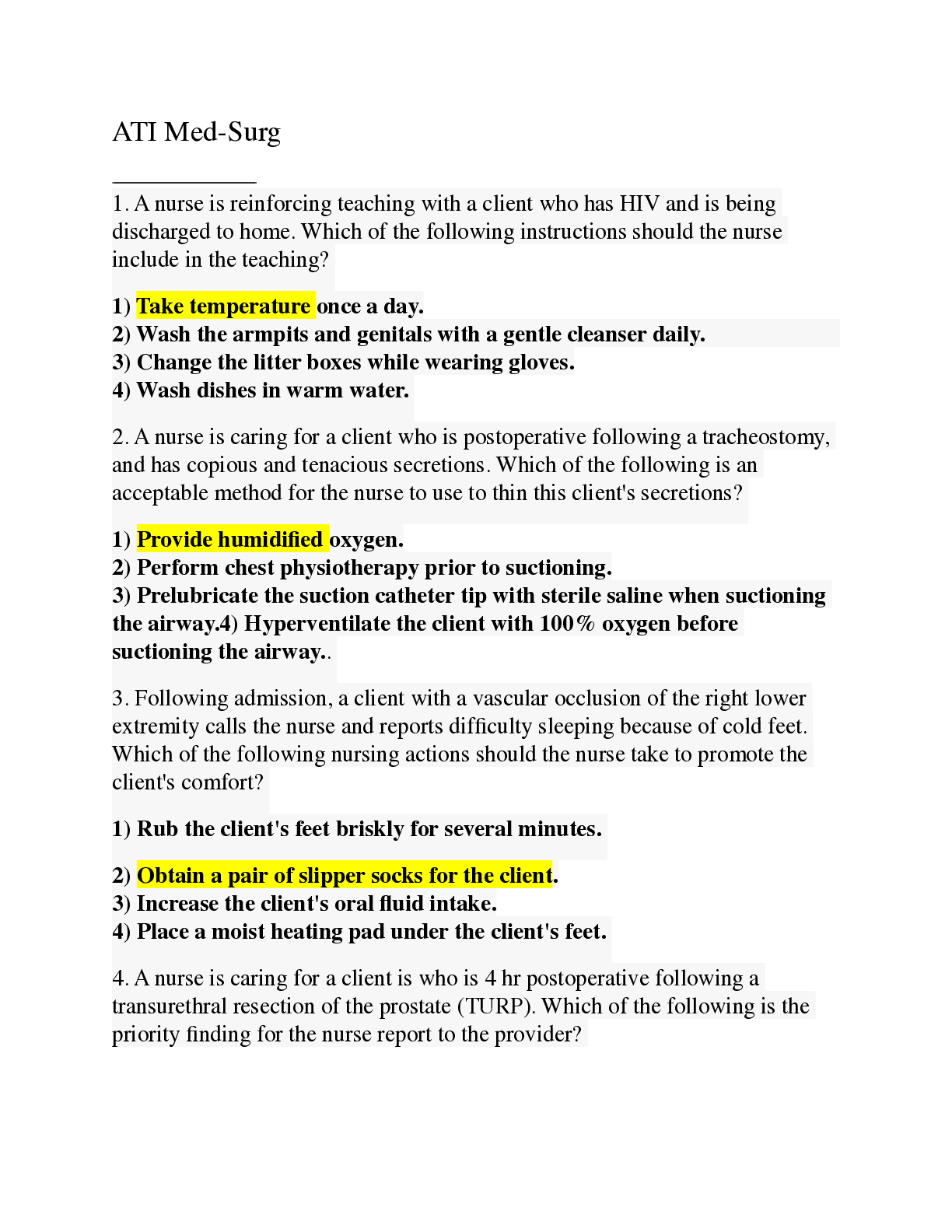
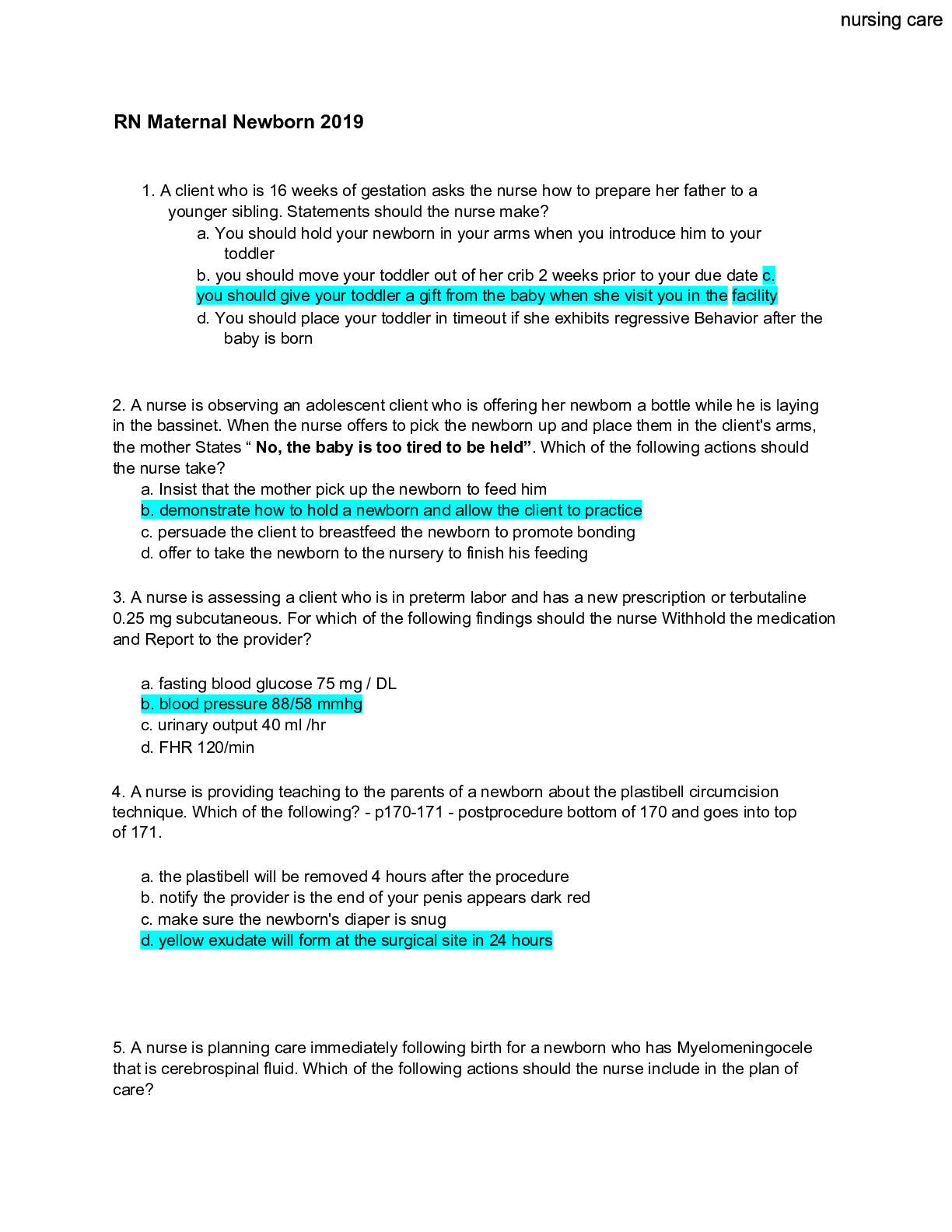
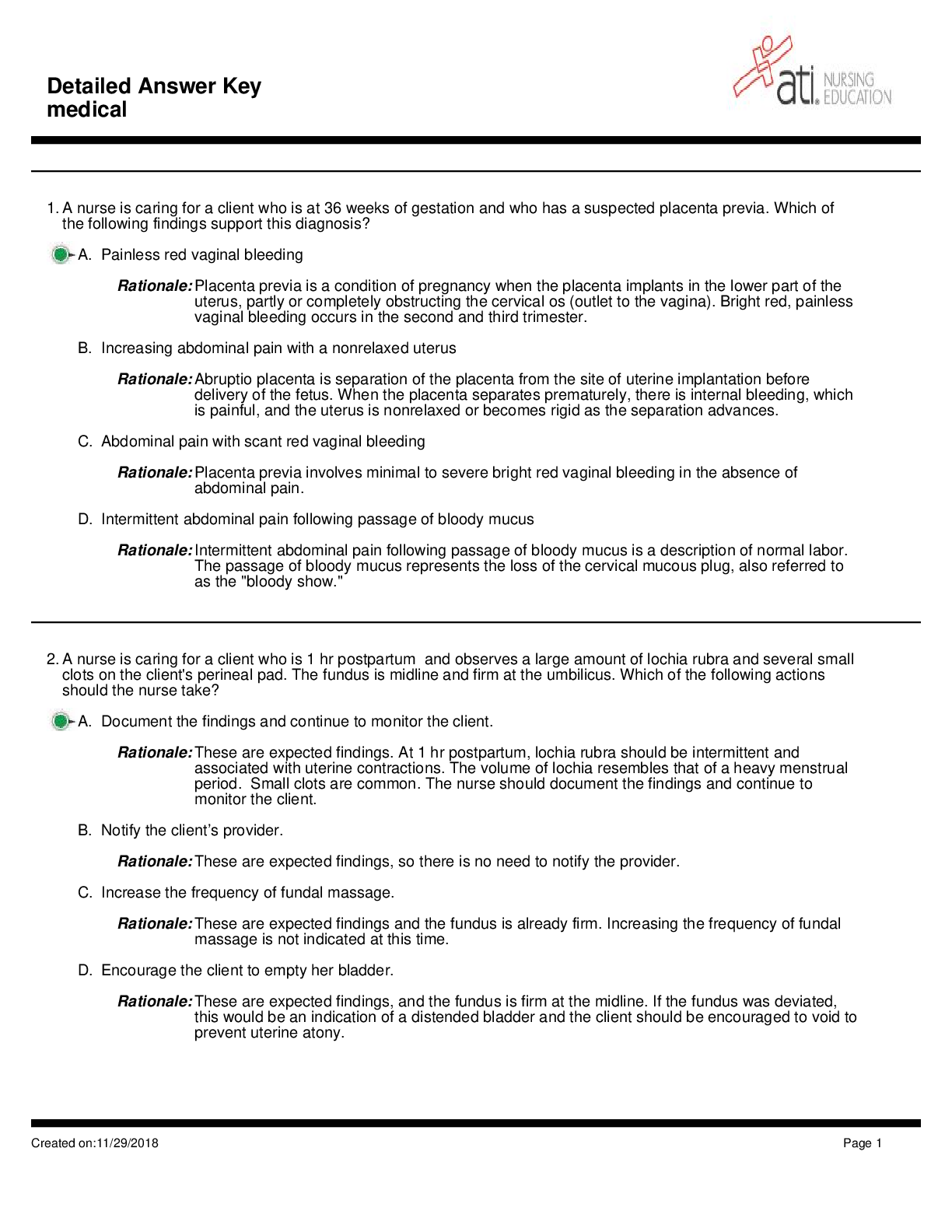
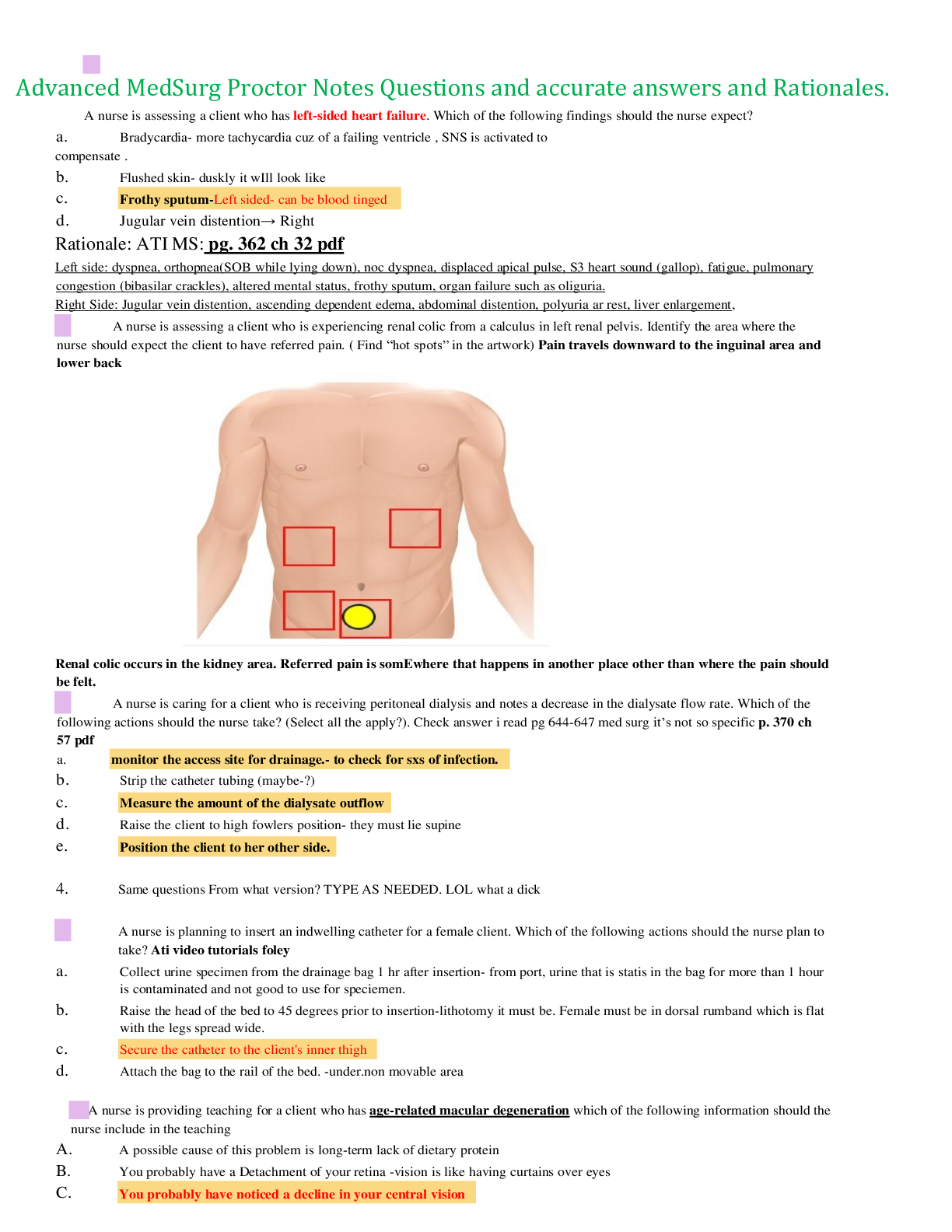
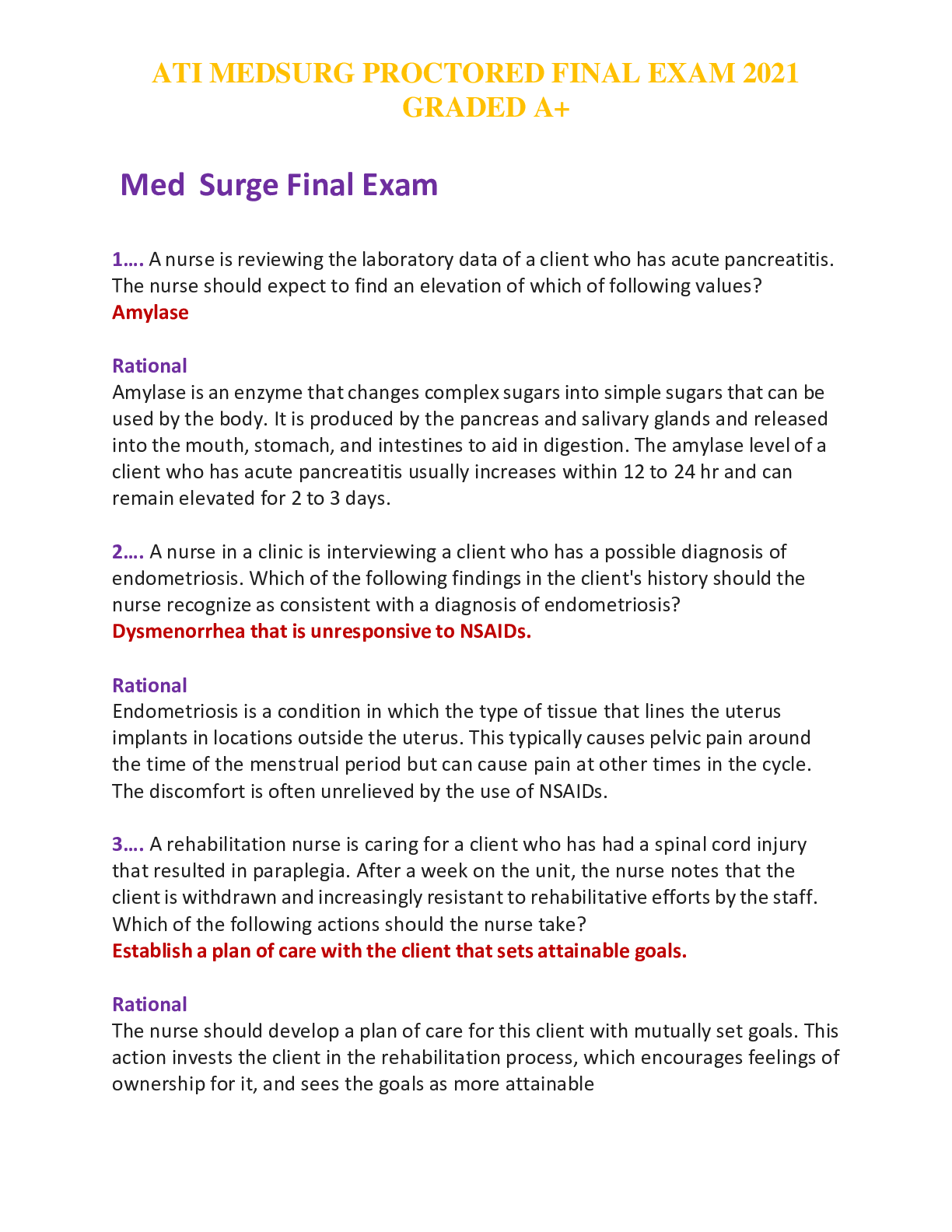

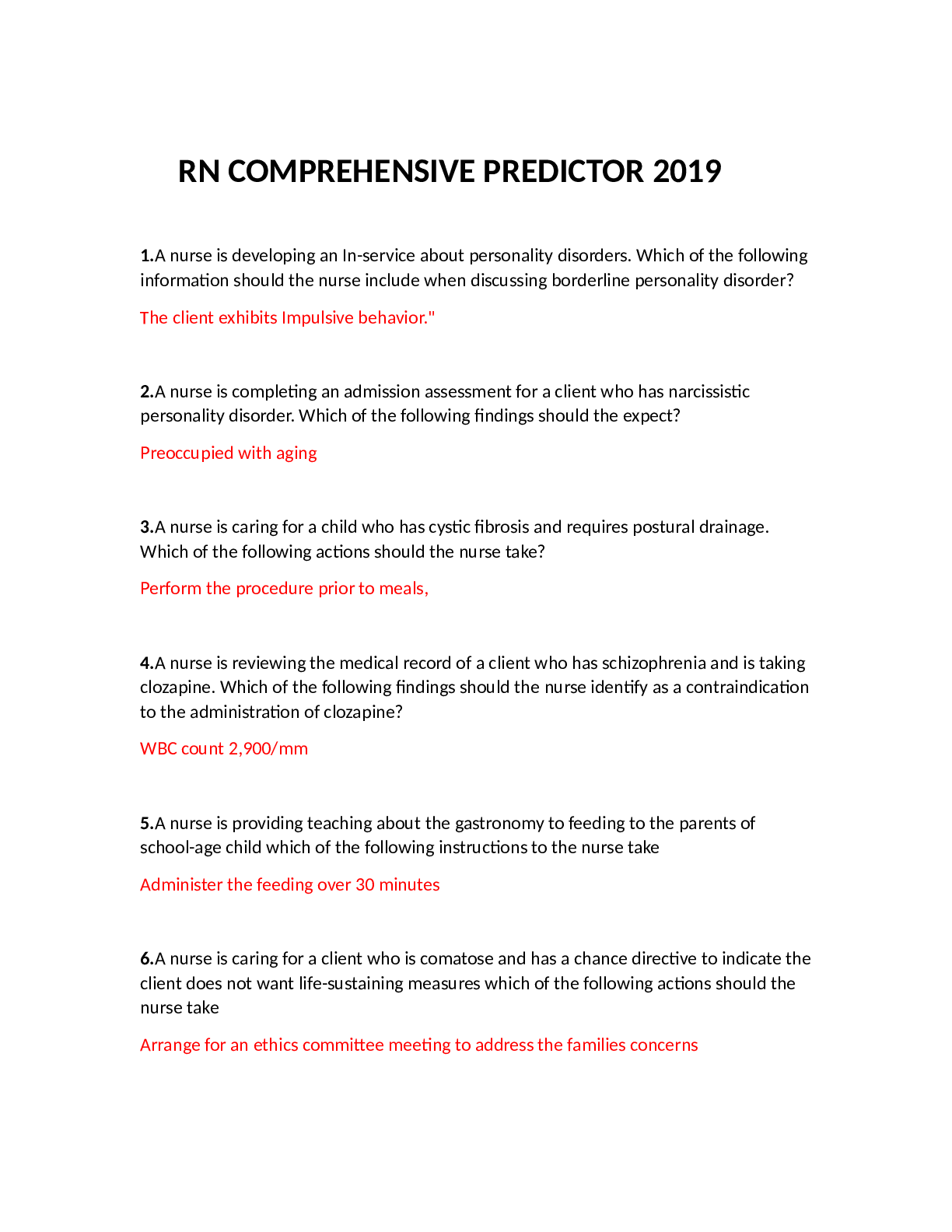
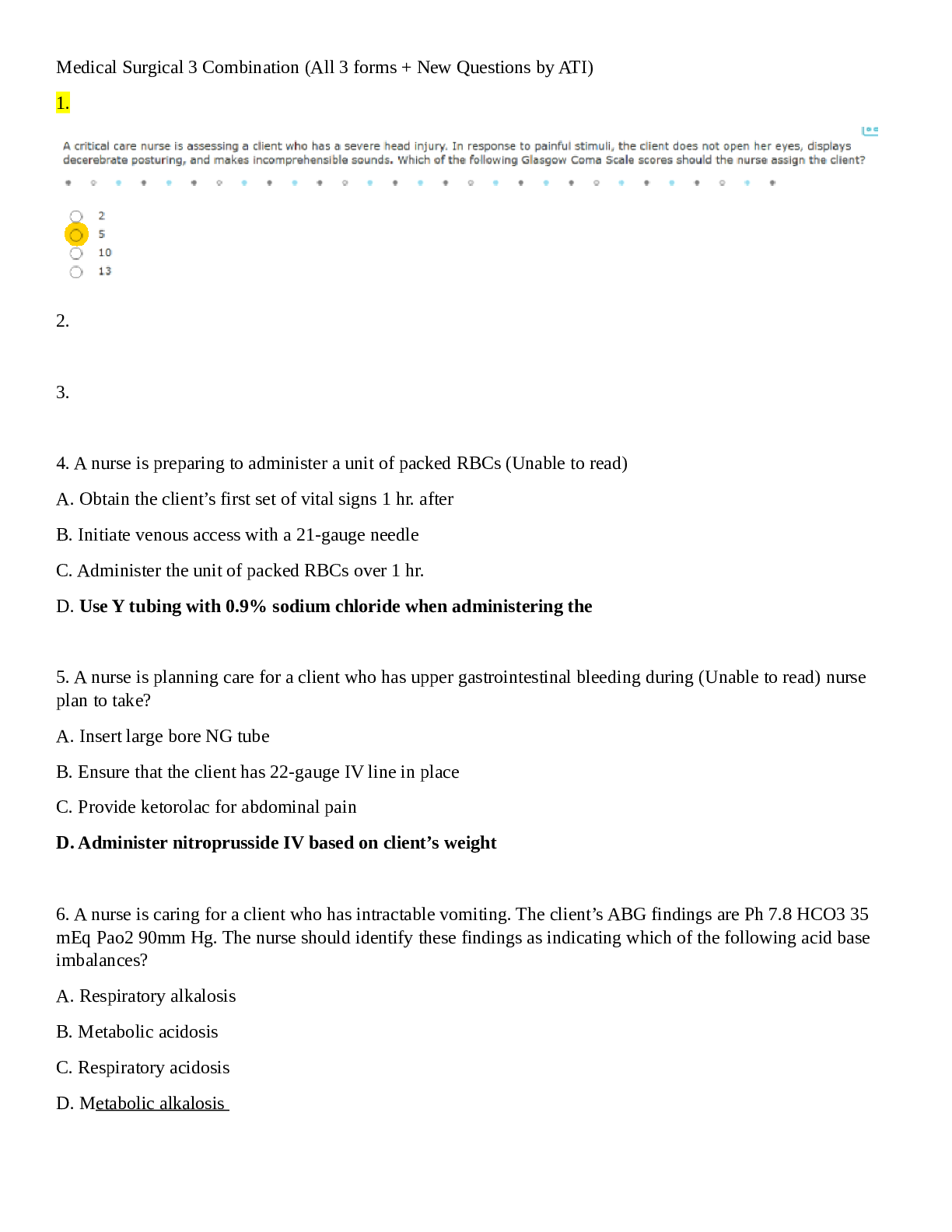
.png)
